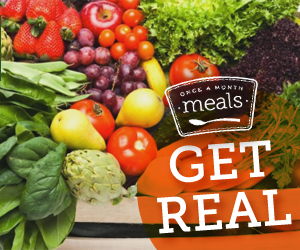**This post is part of the Get Real series. Please remember that this is meant as a learning community. We know that many of you are passionate about what you do and we want you to express that, just please do so in a way that will be an encouragement and aid to others making a transition. We want this to be a “safe space” for participants to learn. For that reason, we reserve the right to delete any comments that are not handled in this manner.
I’d like to welcome Vanessa from Chefdruck Musings, our blog partner this month! Today she’s going to help us to answer our questions on everything beef.
Make the Right Beef Choices
Five years ago I didn’t give much thought to our food supply. Then I saw Food, Inc. and for the first time in my life, I saw slaughterhouses. I saw gigantic farms breeding and raising animals as commodities, and then I saw the output: miles and miles of commingled ground meat. It took me a while to be able to eat a hamburger again.
But I love my meat too much to give it up, so instead, I began to educate myself and make more mindful choices of the meat and milk I purchased for my family. I consulted websites like Eat Wild to find resources for purchasing natural meats. I went on farm tours to learn about why there are so many corn fields, to see how milk is produced, and to understand why so many US cattle are now fed grain. I spoke to farmers big and small to try to understand their point of view.
And then I started thinking more at the supermarket, making more mindful choices, and figuring out what my big issues were, the ones I was willing to spend more money on. Because while it would be nice to simply buy all organic all local, it simply is not possible for us, or for many other families, all of the time. Choosing an all organic, all local diet is simply too expensive for most families. It certainly is for mine, and we live very comfortably in the suburbs of Chicago. Instead, we all make decisions about what to buy every week. We make trade-offs, opting for expensive organic milk but settling for vegetarian eggs rather than cage-free. While we all worry about antibiotics and the humane treatment of animals, we still need to feed our families, and there are only so many dollars we can spend each week at the supermarket. Choosing what type of meat to buy is confusing, and there are many different routes you can take when buying beef, many different issues to consider.
Grass-Fed vs. Grain Fed
The difference seems clear-cut, cattle are either allowed to graze or fed grain, but the standards around what constitutes a grass-fed animal vary. Cattle can spend 2/3 of their life in pasture and then be finished on feedlots getting fatter on grain but still be called grass-fed.
Organic vs. Conventional
Cattle can be grain-fed, but still be organic and antibiotic-free. Some cattle are fed organic grain, and no antibiotics are added to their feed or used in their care by their farms, ensuring that the beef you eat has no traces of antibiotics or synthetic growth hormones.
Humane Living Conditions
Temple Grandin has done amazing work to improve how cattle are slaughtered in America. She has helped farms big and small get a better understanding of how cows experience the slaughterhouse. Humane living and dying conditions are a factor to consider in the meat you purchase. If you want to learn more about this issue, check out the amazing HBO documentary starring Clare Danes about Temple Grandin’s life and how her autism gave her a unique way of understanding animals. With so many issues to consider and so many choices to make, it can be overwhelming.
So how can you get started with changing the type of beef you buy?
Start small. Begin with your ground beef.
Find a local farm or a local meat buying club and purchase your grass-fed organic ground beef from them. The price tag will not be too steep and you’d be surprised at what an impact you’ll be making on your diet. Ground beef is the bulk of the beef we tend to purchase, and just having some in your freezer can make a big difference. You can also grind your own beef from cheaper cuts and make a much tastier burger.
Experiment with Cheaper Cuts.
Grass-fed beef can taste drastically different than grain-fed. Rather than committing to buying an expensive steak and risking having your family not enjoy it, start with cheaper cuts like stew meat or tougher roasts. The Beef Council website has some great recipes for leaner, cheaper cuts that you can even access on your cell phone in front of the butcher case.
Join a Local Meat Buying Club
Through Google, word of mouth, or your local farmer’s market, you can find local meat buying clubs through which you can purchase individual cuts of meat or quarter, half, or even entire cows. This is a great option if you want to be more certain of where your meat comes from. You’ll need a large freezer to store the meat, and you’ll need to pay more. You’ll also need to get used to having unusual cuts and small quantities of the steaks and cuts you do want.
Purchase your Meat at Whole Foods or other Natural Stores
Whole Foods now uses the 5-Step Animal Welfare rating system and tries to be very transparent about all the meat available there. Each time you shop, you can make a more educated decision about what you are choosing to buy. You won’t make the change in weeks, months, or maybe even years. Finding the right beef buying solution for you can be a lifelong project, but if you think about it as an opportunity to experiment, learn, and try new recipes, it can be fun instead of scary and frustrating. Take your time. When you find a new local farm, buy a couple of pounds of beef to try for the month. Think of it as a more delicious form of dating.
May Week 3 Action Item
Each week we will try to give you some simple action steps to put this journey into practice. It is important that you start this journey by understanding yourself, your goals, and perhaps your obstacles
- Try a grass fed organic ground beef. It’s the cheapest cut you can find to start. You can even do a taste test in your house if you’re feeling up for a challenge!
May Get Real:
Please take a moment to thank our guest authors by clicking over to their sites and/or liking them on Facebook and/or Twitter.
Sponsor: Once A Month Meals
*This post contains affiliate links